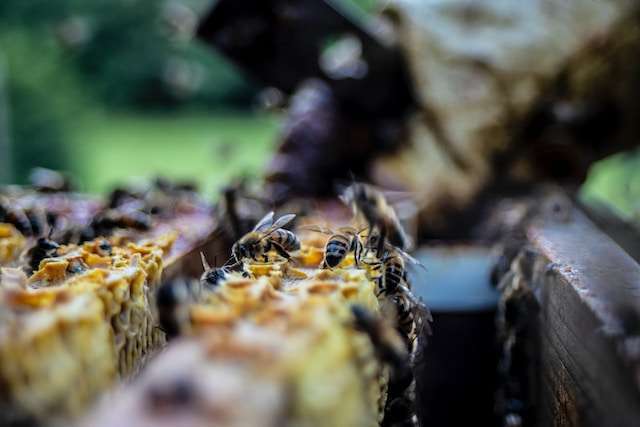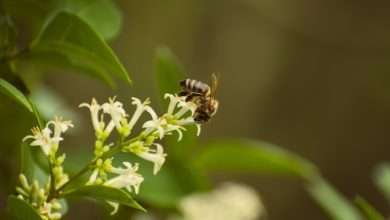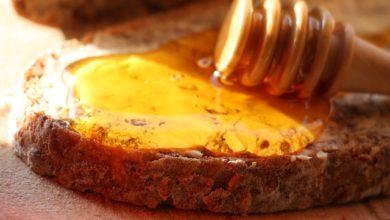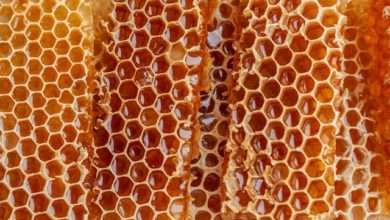How Did the Aztecs Use Honey in Their Daily Lives?

The Aztec civilization, known for its grandeur and intricate traditions, thrived in Mesoamerica from the 14th to the 16th centuries. Within this vibrant society, honey played a significant role, not just as a natural sweetener, but as a symbol of cultural importance and daily sustenance.
This article explores the unparalleled sweetness of honey in Aztec culture, shedding light on its multifaceted significance.
The Significance of Honey in Aztec Agriculture
In the vast and complex realm of Aztec agriculture, a remarkable natural resource played a pivotal role in the success and productivity of their cultivated lands: honey. This golden elixir, produced by the diligent honeybees, held immense significance for the Aztecs, not only as a coveted delicacy but also as a vital component in their agricultural practices.
Aztec agriculture practices and reliance on honeybees
The Aztecs developed sophisticated techniques for beekeeping and honey production, utilizing specially designed clay hives called “ahuexoctli” to house the precious insects.
Beekeeping was a revered practice in Aztec society, and skilled beekeepers played a vital role in maintaining the hives and harvesting honey. Honeybees were cultivated in dedicated apiaries located in close proximity to the agricultural fields, ensuring easy access to their invaluable pollination services.
Types of Bees Domesticated by the Aztecs
The Aztecs domesticated various types of bees, each with its own unique characteristics and contributions to their society.
- Stingless Bees (Meliponini): One of the most prominent types of bees domesticated by the Aztecs were stingless bees, belonging to the tribe Meliponini. These bees, as their name suggests, lacked stingers but possessed other remarkable qualities that made them valuable assets to Aztec agriculture.
- Melipona beecheii: Known as the “Xunan-Kab” in the Mayan language, Melipona beecheii was highly esteemed by the Aztecs due to its impressive pollination capabilities. These bees played a critical role in the cultivation of crops like cocoa, which held immense cultural and economic significance for the Aztecs. The industrious Melipona beecheii efficiently transferred pollen from one cocoa plant to another, ensuring fruitful harvests.
- Scaptotrigona spp.: Another prevalent type of stingless bee was Scaptotrigona, a genus comprising numerous species. These bees were known for their exceptional honey production and served as an essential resource in Aztec apiculture.
- Honeybees (Apis mellifera): While stingless bees were the primary focus of Aztec beekeeping, the introduction of honeybees by Spanish colonizers expanded the diversity of bee species domesticated in Mesoamerica.
- Apis mellifera: Commonly known as the European honeybee, Apis mellifera arrived in the Americas with the Spanish conquistadors. The Aztecs quickly recognized the potential of these honeybees and incorporated them into their existing beekeeping practices.
- Hybridization: Over time, the Aztecs experimented with crossbreeding the native stingless bees with the imported European honeybees. These hybridized colonies exhibited unique characteristics, harnessing the strengths of both stingless bees and honeybees.
The Beekeeping Tradition:
- Beekeeping was an established practice in Aztec society, with specialized individuals known as “meliponicultores” or beekeepers dedicating their lives to the cultivation of honey.
- The Aztecs used cylindrical, ceramic vessels as beehives, housing stingless bees which produced a wide variety of honey.
- These skilled beekeepers carefully tended to their hives, ensuring the colonies thrived in order to extract the precious honey.
Role of honey in pollination and crop cultivation
Honey’s significance in Aztec agriculture extended far beyond its delectable taste. The Aztecs recognized that honeybees played a crucial role in the pollination of their crops, contributing to increased fertility and higher yields. They observed that honeybees diligently transferred pollen from one plant to another, facilitating cross-pollination and enhancing genetic diversity among their cultivated species.
By encouraging greater cross-pollination, the Aztecs harnessed the power of honeybees to create stronger and more resilient crops. This natural process led to the development of hybrid plants with improved resistance to diseases, pests, and environmental stresses. The Aztecs understood that honeybees were diligent allies in their agricultural efforts, ensuring the continued abundance of their food sources.
Honey as a natural fertilizer and its impact on agricultural yield
Apart from its role in pollination, honey had yet another crucial function in Aztec agriculture: it served as a natural fertilizer. The Aztecs discovered that honey possessed unique properties that enhanced the soil’s fertility, ultimately promoting greater crop yield.
When applied to the fields, honey acted as a natural humectant, significantly improving the soil’s water retention capacity. This ensured that crops had access to an adequate water supply, even during periods of drought or limited rainfall. Furthermore, honey’s high sugar content provided nourishment for beneficial soil bacteria and microorganisms, fostering a thriving ecosystem beneath the surface.
Additionally, honey’s rich composition of essential nutrients, including nitrogen, phosphorus, and potassium, acted as a natural fertilizer, replenishing the soil’s nutrient levels and promoting healthy plant growth. The Aztecs recognized that harnessing the power of honey as a fertilizer was a sustainable and environmentally-friendly alternative to chemical fertilizers, allowing them to maintain the productivity of their agricultural lands for generations to come.
Honey as a Staple in Aztec Cuisine

Honey has been a cherished ingredient in culinary traditions for centuries, and the Aztecs were no exception. In Aztec culture, honey was considered a valuable and versatile ingredient, finding its way into various dishes, beverages, and desserts.
Not only was honey used for its delectable sweetness, but it also held significant importance in traditional medicine. In this chapter, we will explore the diverse role of honey in Aztec cuisine, its application in culinary recipes, its use as a sweetener, and its traditional medicinal uses.
- Variety of Aztec Recipes that Incorporated Honey
The Aztecs employed honey in a wide range of culinary creations, showcasing their innovative and resourceful approach to cooking. For instance, one beloved Aztec recipe that featured honey was “Atole,” a traditional hot beverage made from ground corn, water, and flavored with honey. This aromatic concoction was enjoyed during special celebrations and served as a comforting drink during colder seasons.
Another popular dish that showcased the Aztecs’ culinary prowess was “Pollo con Miel,” which translates to “Chicken with Honey.” This savory yet sweet delicacy involved marinating chicken in a mixture of honey, herbs, and spices before grilling it to tender perfection. The combination of honey’s natural sweetness with the savory flavors of the chicken created a harmonious balance that delighted the taste buds of the Aztec people.
Furthermore, “Tamales de Miel” or “Honey Tamales” were a favorite treat among the Aztecs. These soft, fluffy corn-based pastries were filled with a mixture of honey, cinnamon, and various fruits such as pineapple or dried figs. The addition of honey to the tamale dough not only added a natural sweetness but also enhanced the overall texture and flavor.
- Use of Honey as a Sweetener in Beverages and Desserts
In Aztec cuisine, honey served as a primary sweetener, elevating the flavor profiles of beverages and desserts alike. Aztec beverages, such as “Chocolatl,” a foamy and rich chocolate drink, were often sweetened with honey. The combination of bitter cacao and honey’s natural sweetness created a delightful contrast that was enjoyed by Aztec royalty and commoners alike.
Honey was also a key ingredient in many desserts, such as “Xocotl Huetlaxcalli,” a mouthwatering honey and cornmeal cake. This traditional dessert married the flavors of cornmeal, honey, and fragrant vanilla, resulting in a decadent treat that satisfied the Aztecs’ sweet cravings.
- Traditional Medicinal Applications of Honey in Aztec Culture
Beyond its culinary uses, honey held a prominent place in traditional Aztec medicine. The Aztecs believed in the healing properties of honey and utilized it for various medicinal purposes. Honey was often incorporated into herbal remedies, acting as a natural preservative and enhancing the effectiveness of medicinal plants.
In Aztec culture, honey was known to have antibacterial properties, aiding in the treatment of wounds, burns, and skin infections. It was also used as a soothing agent for sore throats and coughs, providing relief and promoting healing. As a natural source of energy, honey was administered to individuals to combat fatigue and boost vitality.
Honey in Aztec Religious and Ritual Practices
The Aztecs had a rich and complex religious system. Their beliefs and rituals played a crucial role in their daily lives, and honey held significant importance in their religious practices.
Use of Honey in Offerings to Appease Gods and Spirits
Honey, with its sweet and golden essence, was considered a precious and sacred substance by the Aztecs. It played an essential role in their offerings to appease the gods and spirits they worshipped. The Aztecs believed that the gods and spirits had the power to grant favor or inflict punishment upon them, so it was vital to maintain a harmonious relationship with these divine entities.
To honor and please the gods, the Aztecs would frequently offer honey as a form of tribute in their religious ceremonies. This act of offering honey was seen as a gesture of respect and devotion, acknowledging the gods’ authority and seeking their benevolence.
Symbolic Importance of Honey in Aztec Religious Ceremonies
Beyond its practical value as an offering, honey held symbolic importance in Aztec religious ceremonies. The Aztecs viewed honey as a representation of abundance, fertility, and the natural cycles of life. It symbolized the sweetness and vitality that the gods bestowed upon the world and humanity.
In Aztec mythology, honey was often associated with the gods of fertility, such as Xochiquetzal and Xipe Totec. These deities were believed to govern the growth of crops, the fertility of the land, and the overall prosperity of the Aztec people. By offering honey, the Aztecs sought to harness the powers of these gods and ensure bountiful harvests, successful reproduction, and overall prosperity for their society.
Furthermore, honey was also linked to the concept of transformation and rebirth in Aztec religious beliefs. Just as bees transform nectar into honey, the Aztecs believed that through their religious rituals and offerings, they could undergo a spiritual transformation and attain a higher state of being.
The Economic Value of Honey in Aztec Society
Honey, a precious and revered commodity in Aztec society, played a pivotal role in the economic framework of this ancient civilization. From its significance as a trade commodity to its production through beekeeping practices, honey held immense economic value. Furthermore, honey’s association with luxury and social status further elevated its esteemed position within Aztec society.
Honey as a Trade Commodity and its Economic Significance
Honey served as a highly sought-after trade commodity within the Aztec society, driving economic prosperity and encouraging commerce. The rich flavors and medicinal properties of honey made it a valuable and highly desirable product for both internal and external trade.
- Commodity Exchange: Honey was regularly exchanged in vibrant marketplaces, bustling with merchants and buyers. These bustling markets facilitated the trade of honey alongside other valuable goods, bringing wealth and prosperity to the Aztec civilization.
- Tribute and Taxation: The importance of honey as a trade commodity can be seen in its inclusion as a tribute demanded by the Aztec emperor. Through this system, conquered regions would provide honey as a form of tribute, further amplifying the economic significance of honey.
Beekeeping Practices and the Production of Honey
Aztec society’s emphasis on honey production reveals the complexity and expertise of their beekeeping practices. This ancient civilization employed innovative techniques to maximize honey production, ensuring a steady supply for both local consumption and trade.
- Apiaries and Bee Farms: The Aztecs developed apiaries and bee farms, housing colonies of bees for honey production. These facilities were strategically placed in regions abundant in flowering plants to provide ample food sources for bees, thereby enhancing honey production.
- Management and Harvest: Aztec beekeepers skillfully managed the colonies, ensuring the health and productivity of the bees. Honey was harvested utilizing various techniques, such as smoking the bees to calm them before collecting the honeycombs.
Honey as a Luxury Item and its Role in Social Status Differentiation
Honey’s association with luxury and prestige further solidified its economic value within Aztec society. This sweet delicacy held a significant place in the social fabric of this ancient civilization, differentiating individuals based on their access to and consumption of honey.
- Elitism and Social Status: In Aztec society, honey became a symbol of wealth and social standing. The elite class had exclusive access to the finest honey varieties, reflecting their elevated social status. Consuming honey was seen as a luxury that set this privileged group apart from the masses.
- Rituals and Ceremonies: Honey’s luxurious status extended to religious and ceremonial practices. It was utilized in sacred rituals, offering a link between the divine and mortal realms. The consumption of honey during important events showcased an individual’s high societal position and further reinforced their social status differentiation.
The Medicinal Properties of Honey in Aztec Culture
Within the rich herbal tradition of the Aztec civilization, honey played a significant role in the realm of healing and medicine. Revered for its remarkable properties, honey was not only a delectable treat but also a potent remedy for various ailments, wounds, and infections.
- Healing Properties Associated with Honey in Traditional Aztec Medicine:
In Aztec culture, honey was believed to possess incredible healing properties, making it an essential component of their medicinal practices. It was esteemed for its anti-inflammatory, antimicrobial, and antioxidative attributes, rendering it a versatile remedy for a plethora of health issues. According to Aztec healers, the consumption of honey not only helped soothe and alleviate illnesses but also promoted overall well-being.
- Use of Honey in Treating Various Ailments, Wounds, and Infections:
The Aztecs embraced honey as a natural remedy to combat an array of health conditions. It was widely used to treat respiratory problems such as coughs, sore throats, and congested chests. Additionally, honey was administered to alleviate digestive disorders, including stomachaches and indigestion. Its soothing properties provided relief from gastrointestinal discomfort, offering comfort to those suffering from such ailments.
Moreover, honey’s antimicrobial characteristics made it ideal for treating wounds and infections in Aztec society. By applying honey topically, the Aztecs found that it promoted wound healing, prevented infection, and reduced inflammation. The sticky texture of honey created a protective barrier over the affected area, shielding it from external contaminants and facilitating a speedy recovery.
- Honey as an Ingredient in Remedies and Ointments Used by Aztec Healers:
Aztec healers ingeniously incorporated honey into various remedies and ointments to enhance their healing properties. One such notable preparation was a honey-based mixture infused with medicinal herbs, pollen, or propolis. These concoctions were employed as treatments for skin conditions, respiratory ailments, and even as immune boosters. The inclusion of honey amplified the effectiveness of these remedies, allowing for both internal and external application.

Additionally, honey served as a crucial ingredient in ointments used by Aztec healers to treat burns, cuts, and bruises. By combining honey with other natural substances like aloe vera and herbal extracts, they concocted powerful healing ointments that expedited the regeneration of damaged tissues and minimized scarring.
Conclusion
The significance of honey in Aztec culture was far-reaching, extending well beyond its role as a simple sweetener. Through their mastery of beekeeping, the Aztecs harnessed the divine essence of honey, integrating it into religious rituals, daily sustenance, and economic activities. This unparalleled sweetness of honey permeated every aspect of Aztec civilization, leaving a lasting legacy that underscores the rich cultural heritage of this remarkable society.
FAQs
How did the Aztecs obtain honey?
- The Aztecs practiced traditional beekeeping methods and utilized both wild and domesticated bees. They constructed hives made from hollow logs, clay pots, or woven baskets to attract and house bees. Honey was obtained by carefully collecting and extracting it from these hives.
Did the Aztecs produce honey on a large scale?
- While the exact scale of honey production is not known, the Aztecs were skilled beekeepers and it is believed that they cultivated honey on a significant scale. Aztec rulers and elite members of society often boasted large estates with extensive apiaries to ensure a stable supply of honey.
How did the Aztecs store honey for long-term use?
- To preserve honey, the Aztecs stored it in airtight containers such as clay jars or gourds tightly sealed with wax or cloth. These methods helped maintain the quality and freshness of the honey over extended periods.



